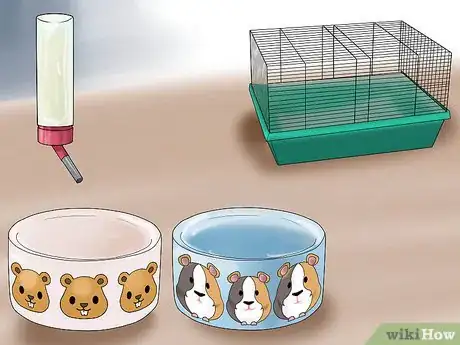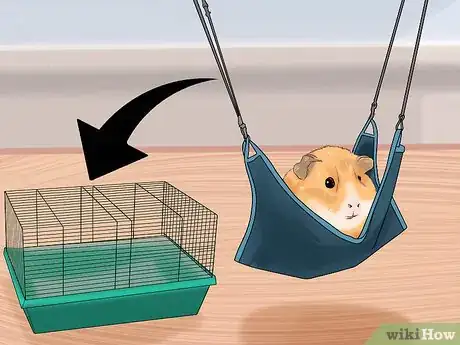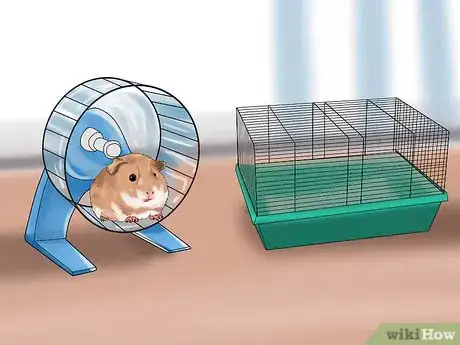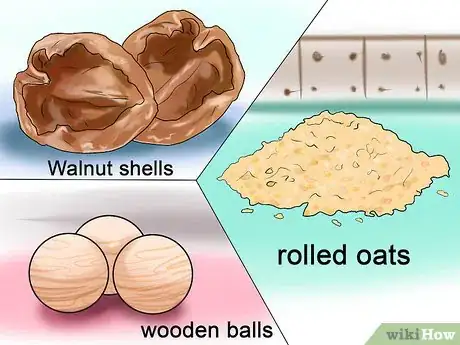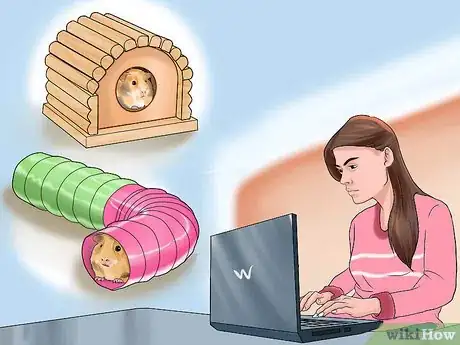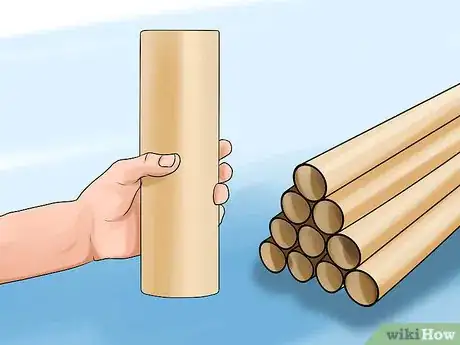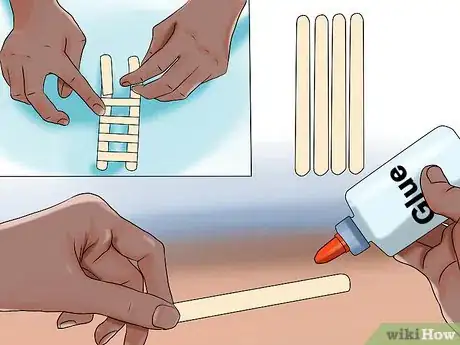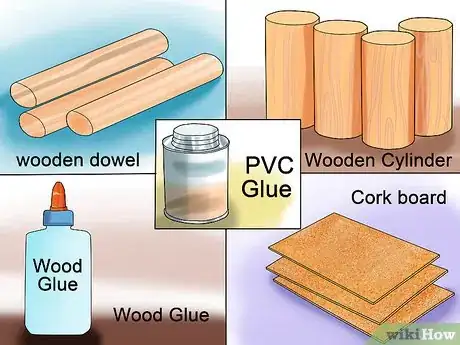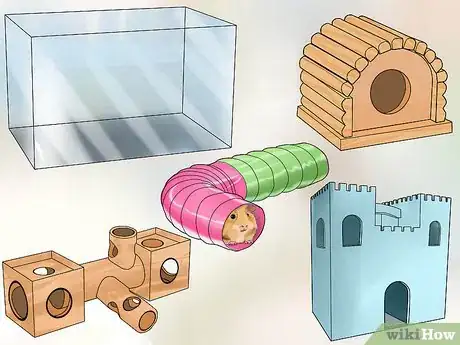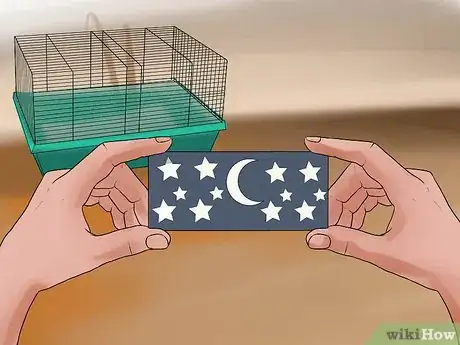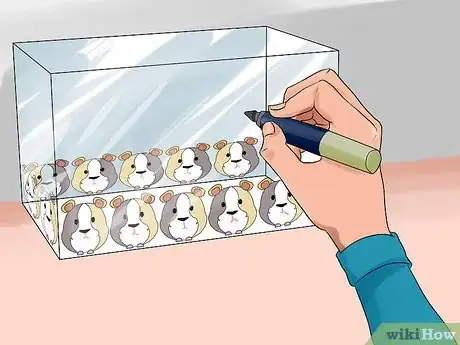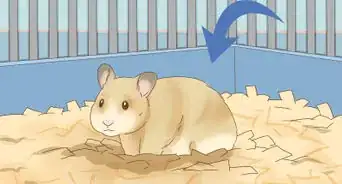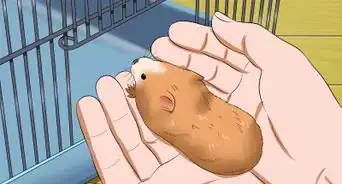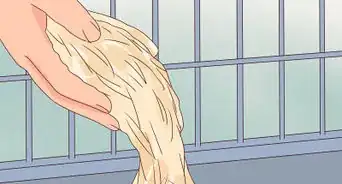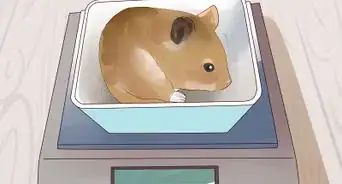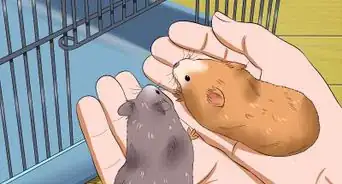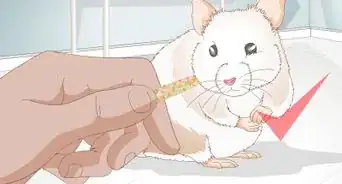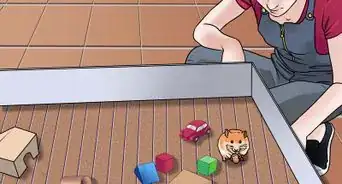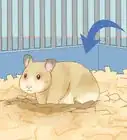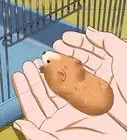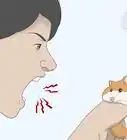This article was co-authored by Pippa Elliott, MRCVS. Dr. Elliott, BVMS, MRCVS is a veterinarian with over 30 years of experience in veterinary surgery and companion animal practice. She graduated from the University of Glasgow in 1987 with a degree in veterinary medicine and surgery. She has worked at the same animal clinic in her hometown for over 20 years.
This article has been viewed 22,063 times.
Perhaps you just adopted a hamster, or maybe you need to spruce up your hamster’s cage. Now that you have a cage, you need to fill it with goodies for your hamster. There are many different kinds of toys, chew blocks, and nests you use to decorate your hamster's home while giving them everything they need. You can buy accessories or, with a little creativity, you can make your own!
Steps
Providing Stylish Necessities
-
1Choose a fun food bowl. You should look for a heavy ceramic food dish that they can’t tip over. You can mix things up by finding a small bowl or dish that has bright colors, a neat design, or an unusual pattern. Good places to look for these include home goods stores, thrift shops, or supermarkets. Choose a smaller bowl that can contain around 5 oz. or a couple of tablespoons of pellets. Be sure to wash it out well before giving to your hamster.
- Be sure to hook a water bottle onto the cage. Your hamster will need water in addition to food.
-
2String up a hammock. Buy a nylon hammock instead of a fleece or cotton one to ensure that your hamster won't chew through it. Hang the hammock in the corner of a cage. Make sure that your hamster is able to climb onto it with ease. Hammocks are actually proven to make hamsters happier, so it is a good purchase.[1]Advertisement
-
3Place a plastic wheel in the cage. Hamsters need a wheel for exercise. You want a wheel that has a solid, plastic bottom, not spaced rungs. Hamster feet can get stuck in the rungs! You can find wheels in many different kinds of colors these days, so shop around.
-
4Sprinkle in plenty of chew toys. Hamsters need to grind down their teeth by chewing. There are plenty of chew toys you can give your hamster to make him happy that will also make the cage look great. Walnut shells, unpainted oak or Cherrywood squares, wooden balls, and rolled oats are all great for chewing.
-
5Design a maze with plastic tubing. You can buy plastic tunnels for your hamster online or at the pet store. These are sometimes known as habitrails. They snap together to create pathways between different houses, nets, or tanks. You can also create your own maze. Find many different parts, including straight pieces, curves, ramps, and nesting boxes. Snap these together, making sure that they are secure.
- Many wire cages have holes where these tunnels attach. These cages are called “modular” habits.[2]
- Make sure that the maze either circles back to the cage or that there is a suitable “dead end,” such as a nesting box or a separate cage.
Making Your Own Toys
-
1Collect empty cardboard tubes. When you run out of toilet paper, save the paper rolls. You can also use paper towel tubes. Put these around the cage. Your hamster will use them as tunnels, and they may chew on them a little bit. You can have multiple tubes in a single cage.
- Replace the tubes once they have been chewed through or if they become damp.
-
2Fashion ladders out of popsicle sticks. Gather at least four popsicle sticks. Cut two in half, and sand down the rough edges.Using non-toxic glue, attach the pieces so that they form a ladder. The cut pieces are the rungs, and the uncut pieces are the siderails. Make sure that there is a short gap between the rungs. Hamsters love to climb, and giving them ladders will help them exercise while sprucing up your cage.[3]
-
3Build your own hamster platform. For this, you will need a piece of corkboard, miniature wooden dowels (about 8x40 mm in size), four wooden cylinders, and wood glue/PVC glue. Glue the cylinders onto the bottom of the corkboard for legs. Wait fifteen minutes before flipping over. Glue the dowels around the edge of the corkboard to form a fence. Leave a gap so hamsters can enter.[4] Be sure to prop a ladder against it so hamsters can climb up to it.
- Let the glue dry completely for a few hours before placing it in the hamster cage.
-
4Create a swing out of a tin can. Clean out a tin can. Make sure that both ends are removed, and sand down the rough edges until they are smooth. There should be no jagged edges or protruding parts. String a wire or a thin chain through the can, and attach both ends to the top of the cage. The swing should hang low enough for your hamster to crawl in and out. You may leave a ladder out for your hamster.[5]
- Do not use string. Your hamster may chew on the string, causing digestive problems.
-
5Paint a flowerpot nest. You want to find a pot that is small enough to fit in your cage but large enough to house your hamster. Paint this with fun colors using non-toxic paint. When it is completely dry, tip it on its side in the main part of the cage. Your hamster will fill it with bedding to sleep in.
- Do not use stickers as your hamster can eat these.
Decorating Your Cage
-
1Choose a theme. Before you start decorating the cage, think of a fun theme for your hamster cage. Some people decorate their cages for certain holidays. Others stick with certain colors. Think about how you want your cage to look. Some ideas are:
- Space
- Christmas
- Seasons like Spring or Fall
- Desert
-
2Fill the cage with decorative toys and tunnels. Hamster toys come in a variety of colors and shapes. Nesting boxes can be found as igloos, animals, or cottages. There are wooden bridges, tree-shaped tunnels, and miniature castles. Find toys and accessories that fit your theme, or use what you think is cute. Remember, hamsters need plenty of hiding spaces, tunnels, climbing walls, and chew toys so you can look for several different options.
-
3Hang up a picture. You can provide some extra scenery to the cage by printing or drawing a landscape. This should be as tall and wide as their cage. You can choose a normal woodland scene or chose something that fits your theme (stars and planets for a space theme, pine trees and snow for Christmas, etc.).
- If you have a tank or aquarium cage, you can attach this with tape to the back of the tank. Place it on the outside of the tank with the picture facing into your hamster’s home. Do not put it inside the cage.
- If you have a wire cage, glue it onto cardboard. Prop it up behind the cage, just far enough away from the cage so that the hamster cannot chew on it.
-
4Draw on tank walls with dry erase markers. If you have a bin, aquarium, or tank style of cage, you can draw designs or notes on the glass side with a dry erase marker. Only draw on the outside of the cage. You can erase it with a dry eraser or with a damp cloth.[6]
- You can also place stickers on the glass so long as there is no chance they will peel off and fall into the hamster’s living area.
Warnings
- Avoid products that use string instead of wire or chain as the hamsters can swallow this.⧼thumbs_response⧽
- Do not use pine shavings, cedar shavings, fluff, wool, newspapers, or scented bedding as bedding for your hamster as these can cause injury or harm your hamster.⧼thumbs_response⧽
References
- ↑ http://www.sciencemag.org/news/2015/07/how-tell-if-your-hamster-happy
- ↑ http://www.humanesociety.org/animals/hamsters/tips/hamster_housing.html
- ↑ http://animals.mom.me/build-hamster-toys-out-household-items-4565.html
- ↑ http://dwarfhamsterblog.com/diy-hamster-platform/
- ↑ http://animals.mom.me/build-hamster-toys-out-household-items-4565.html
- ↑ https://www.youtube.com/watch?v=0FK1BLgpoys&feature=youtu.be&t=89
About This Article
To accessorize your hamster's cage, try placing a couple of empty paper towel rolls in it so your furry friend has tunnels to run through and chew on. You can also glue popsicle sticks together to make a ladder for your hamster to climb on in its cage. If your hamster doesn't already have a swing, you can easily make your own by removing both ends from a tin can, stringing a thin chain through it, and attaching the ends of the chain to the top of the cage. Just make sure you sand down any sharp edges on the can before you let your hamster play in it. To make your hamster its very own shelter to sleep in, paint a small flower pot with non-toxic paint, then place it on its side in the cage and fill it with bedding. For tips from our Veterinary co-author, like how to decorate your hamster's cage, keep reading!
